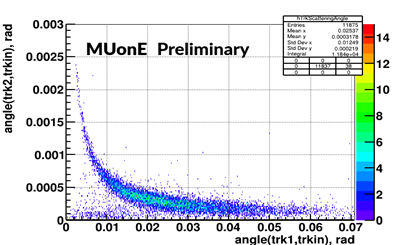MUonE Test Run at CERN: a first milestone towards the final experiment

Candidate elastic scattering events in the plane of the scattering angles of the two outgoing particles.
The MUonE experiment aims to determine the hadronic contribution to the muon g-2 (aμHLO) using an innovative approach, based on the direct measurement of the hadronic component to the running of the electromagnetic coupling constant. This will help to clarify the present tensions between the two methods currently used to calculate aμHLO, one based on lattice QCD calculations, the other relying on e+e- data.
MUonE plans to extract the hadronic component to the running of ⍺ by measuring the shape of the differential cross section of the μ-e elastic scattering. The measurement will be performed by scattering a high energy muon beam on the atomic electrons of a low-Z fixed target. The scattered particles will be then detected by a tracking system composed of silicon strip sensors.
The M2 beamline at CERN’s North Area provides an ideal environment for this measurement, given its 160 GeV muon beam with an in-spill intensity of ~40MHz.
From August 21st to September 11th, MUonE carried out a Test Run at the M2 beamline with a prototype detector, composed of two tracking stations and a calorimeter.
Leverhulme International Professor Graziano Venanzoni, PDRAs Saskia Charity, Fedor Ignatov, Andrea Loreti, Riccardo Pilato and Ce Zhang, and PhD student Katie Ferraby strongly contributed to the operations and prompt data analysis during the Test Run.
The Liverpool group will now extend the effort to the offline analysis of Test Run data, and will continue its activities to develop a light mechanical structure for the MUonE tracker and to upgrade the beam magnet spectrometer at the M2 beamline.
MUonE plans to submit a technical proposal to the SPS Committee in 2024 asking for a first physics run in 2025. The final run with the full detector is then envisaged after the Long Shutdown 3.